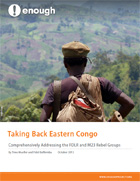
Over the past 19 years, one of the most intractable symptoms of mass violence in Congo’s eastern regions has been the proliferation of armed groups that threaten security, perpetrate horrific human rights abuses, and undermine economic development. Two of these armed groups—the M23 and the Democratic Forces for the Liberation of Rwanda, or FDLR—not only have committed some of the worst atrocities in the conflict, but they have also internationalized it in multiple ways. The FDLR is headed by some of the perpetrators of the 1994 Rwandan genocide, and it has attacked Rwanda in the past year. Kigali believes the FDLR poses an existential security threat. The M23 is an offshoot of several previous rebel groups, and the United States and other groups have linked it to the Rwandan government, but Kigali denies the link. Therefore, dealing with these two groups addresses one of the most destabilizing factors in the Great Lakes region: the relationship between Congo and Rwanda. The Allied Democratic Forces, or ADF, is also becoming a destabilizing force in Congo and threatens Congolese communities and Uganda.
With the passage of U.N. Security Council Resolution 2098, the United Nations created a 3,000-troop Intervention Brigade with a mandate to “carry out targeted offensive operations” against armed groups in the east of the Democratic Republic of the Congo, or DRC.3 The brigade is the United Nations’ first offensive combat unit.4 Nearly five months after its creation, and against a backdrop of growing popular frustrations that sparked massive demonstrations and stoning of U.N. cars, the brigade joined the Congolese army in fighting the M235 between August 21 and August 30, 2013.6 The U.N. Intervention Brigade’s first public operation exposed the well-documented complexities of the area, the actors, and the problem that the force was designed to address.
In the aftermath of the fighting, on September 10, 2013, the DRC government and M23 agreed to resume peace talks in neighboring Uganda. At this stage, the Congolese government seems reluctant to offer amnesty and reintegration to M23 members suspected of committing the worst human rights crimes. But it is unlikely that M23 leaders would sign a peace agreement without an amnesty option. One possible way to pressure M23 into conceding to an agreement is to step up pressure on and provide new incentives to its alleged ally, Rwanda. Refocusing international attention on Rwanda’s adversary, the FDLR, could provide a means of gaining the necessary political buy-in from Rwanda to help end the M23 rebellion and address a persistent source of insecurity to the Congolese people.
With that said, to incentivize Rwanda to help convince the M23 to sign a deal requires far more than a refocusing on the FDLR alone. With the Kampala talks unable to address Congo’s and Rwanda’s security and economic interests, it is important to bring the discussions to a swift conclusion, opposing any amnesty for M23 rebels implicated in war crimes. For the worst violence in Congo’s east to end, the Kampala talks should transition into a regional peace process on security and economic interests.
Complementing the Enough Project’s forthcoming report on regional economic integration, this field report discusses the prominent security concerns of Congo and Rwanda. It provides analysis of recent and historical developments, evaluates a range of options for addressing the M23, and advances a new strategy for containing and neutralizing the FDLR. The elements of such a strategy would ideally include a beefed-up effort to increase defections, a vastly upgraded mediation effort involving regional and internal Congolese actors, a revamped security-sector-reform initiative, and a more effective military strategy led by the Intervention Brigade.

